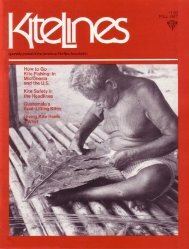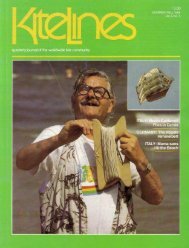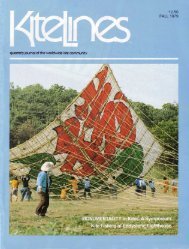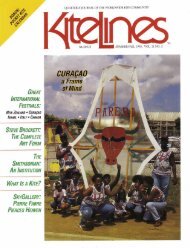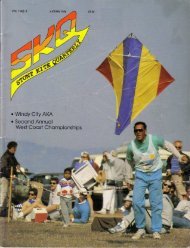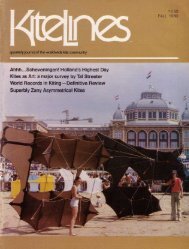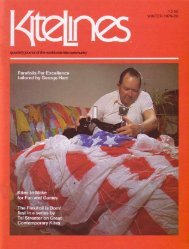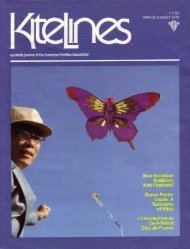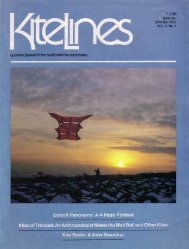THE DUTCH KITE2. Open paper flat . Fold and crease ona line 3" from the top (short way) . Foldand crease 3/4" from this fold . This willform a horizontal ridge .3 . Unfold the 3/4" -wide crease and cuton heavily marked lines .4 . Open paper flat, ridge side down .Brush glue on top and bottom sections ofthe long vertical fold (between the foldlines) but not on the horizontal fold sectionwhere the H-shaped slit is . Laybamboo reed, cut to size, on the centercrease, a short piece above the crossfold and a long length below . Fold incenter, spreading sides out flat, thusgluing the spine of the kite .5 . The cut flaps on the intersection overtical and horizontal ridges (crossfold) should slide over each other, onEcoming out on front of the kite, the otheron the back . Glue these flaps down orfront and back of kite .6 . On the back, brush glue on the crossfold and horizontal ridge area . Lay bambooreed in the crease . Bring together toform the horizontal ridge . Trim off topcorners .<strong>No</strong>w for the bridle :7 . Take two scraps of paper, each piece2x2 ½ ", and fold in half, across the 2"dimension . Fold in half the other way andsnip a small corner off the center fold,making a hole in the center of the paper .On one scrap, cut about 3/4" up themiddle fold below the corner cut .8. Open pieces up . Tie each end of the24" string to the center of a 2" bambooreed . Thread the sticks through the holesin the small papers, so that the sticks ridein the creases and the papers are linkedby the string .9 . Over the intersection of the ridges(parallel to the vertical ridge), glue thepaper with the slit, which separates tofit over the horizontal ridge . The otherend of the bridle is glued over the verticalridge at the bottom of the kite . Last,glue on the tail, a 4' strip of 1"-widecrepe paper to the bottom center backof the kite .A simple way to set the bridle angleon a light kite : Slip a finger through thebridle string, so it forms a right angle withthe kite at the juncture of the uprightand cross ridges . With the other hand,pinch off a loop in the string, bringingthe part of the string nearest the top ofthe kite up to meet the other portion .Pick a m de open place, fly and enjoy!FURTHER EXPERIMENTSKeeping the same proportions, you canscale the Dutch <strong>Kite</strong> down to as smallas 3x4" (before folding) . For tiny versions,use crisp, lightweight paper,broom straw for reinforcements, andmake the folds and the scraps for thebridle assembly as narrow as possibleto save weight . Fine strips of crepepaper will serve for tail . Fly on "crystal"thread, a very fine monofilament, soldin sewing centers . (Anything heavierwould mean a flying line heavier thanthe kite .) These pocket-sized kites flywell, but they need a fairly strong windand considerable skill .Dutch <strong>Kite</strong>s scaledlarger than standard aregiraffes, subject to slippeddiscs and other backailments .The Dutch <strong>Kite</strong> is excellentfor flying in train. Use15-lb .-test line for the masterline, to which all the kiteswill be tied . Tie the first kiteto this line and let it outabout 50 feet. Using crochetthread, or other light flyingline, put up a second kite tcabout 25 feet. Tie a loop inthe master line, break off thesecond line and tie it throughthe loop . You now have twokites on one line, and cancontinue adding others in thesame manner. The addedkites help take the drag fromthe line, and the limit you canfly in this way is unknown . 0
ClassifiedsServices and products are listed as a service and listingdoes not imply endorsement by the American <strong>Kite</strong>fliersAssociation . Publisher reserves the right to reject any adnot in keeping with publication's standards, and toabbreviate to save space . Rates : 20C per word, $2minimum . Post office box numbers and telephone numberscount as two words, abbreviations and zip codes asone word . Check or money order, made payable toAmerican <strong>Kite</strong>fliers Association, must accompany copyand be received prior to closing date (as given onmasthead, page 5) . Send to <strong>Kite</strong> <strong>Lines</strong> Classifieds, 7106Campfield Road, Baltimore, MD 21207 .WANTEDCLIPPINGS : News and articles of kite interest are activelysolicited by AKA . First person to send an original withname and date of source will receive a small reward .Later duplicates received will be returned if sender suppliesstamped, self-addressed envelope . Send clippingsto American <strong>Kite</strong>fliers Association, 7106 Campfield Road,Baltimore, MD 21207 .INFORMATION on rare kite materials sought for exchangeby AKA . Reliable suppliers of bamboo, aluminumtubing, fiberglass rods, Tyvek", Mylar", nylon rip-stop,plastics, rice paper, glues, tapes, line, fixtures, etc ., areencouraged to write and/or send samples to AKA, givinglull details of sizes, grades, colors, prices, etc . Send toAmerican <strong>Kite</strong>fliers Association, 7106 Campfield Road,Baltimore, MD 21207 .OLD KITES : Lewis fishing kite, WWII box kites (emergencyequipment), etc ., old books, articles, about kites . Willpay. Pat Hammond, 215 Argyle, San Antonio, TX 78209 .FOR SALE -KITESNEW MODELS : The New England <strong>Kite</strong>crafting Co .announces the availability of 3 new kites all made from1 .5-oz . rip-stop nylon : (1) a giant delta with 9' wingspanand fiberglass spars, $30 ; (2) a 40" French military withkeel, $20; (3) a 36" French military with bridle, $18 . Seeour full-page ad on page 12 for construction details andfor information on ordering :FOR SALE-MISCELLANEOUSNO WIND? FLY HOT AIR-Build and fly a 9' hot airbaIIoon. Complete kit with pre-cut gores, inflating instructions,and hot air history. $4 ppd . SNOOLLABBALLOONS, 2908 Harvey #2, Madison, WI 53705 . Wholesaleinquiries welcome .FILM : "How to Fly a <strong>Kite</strong>," 3-min . black/white 16mmsound movie in "silent" style . Lightly educational, definitelydelightful . Prints $25 . TLM Productions, 8 CharlesPlaza, #1807, Baltimore, MD 21201, (301) 685-2370 .SLIDE SHOWS : Two educational 80-slide shows, "AllManner of <strong>Kite</strong>s" (about 14 min . on history and varieties)and "How to Go Fly a <strong>Kite</strong>" (about 9 min . on flyingtechniques, contests), to show separately or in successon, with synchronized tape cassettes . Rentals are $15ea . or $25 for both for 3 days, including ship . one way .Rentals may apply to purchase prices of $45 per show or$75 for both in trays with tapes . (Also available withscripts instead of tapes at $40 ea . or $70 for both .)Write for order form to Maryland <strong>Kite</strong> Society, P .O. Box10467, Baltimore, MD 21209, or call (301) 484-4861or 655-9320 .Super <strong>Kite</strong>s, book by Neil Thorburn, $2 .50, 4738 ElmhurstDr., San Jose, CA 95129 .LIMITED NUMBER of kite books : World on a String, JaneYolen, $5 .95 ; <strong>Kite</strong> Craft, J . & L . Newman, $4 .95 ; CompleteBook of <strong>Kite</strong>s and <strong>Kite</strong>flying, Will Yolen, $9 .95 . Pricesinclude mailing at book rate . Send check or money orderto : Bob Ingraham, P. 0 . Box 1511, Silver City, 188061 .BACK ISSUES of <strong>Kite</strong> Tales magazine beginning withVol . 8, #4 and extending through Vol . 10, #3 only. $2 ea .including mailing. Order from : Robert M . Ingraham, P. 0 .Box 1511, Silver City, NM 88061 .AKA EMBLEM PATCHES now available direct from AKA .Washable, red-white-and-blue, 2%x2/", $1 .75 ea . (2for $3 .25, 3 or more $1 .25 ea, all postpaid . (Foreignorders add estimated postage .) Send check or moneyorder to American <strong>Kite</strong>fliers Association, 7106 CampfieldRoad, Baltimore, MD 21207 .RETAILERS LISTINGThe <strong>Kite</strong> Kompany, Inc ., 33 W . Orange, Chagrin Falls,OH 44022, (216) 247-4223 .The <strong>Kite</strong> Shop, Jackson Square, 542 St. Peter St ., NewOrleans, LA 70116, (504) 524-0028 ..The <strong>Kite</strong> Site, 1075 Wisconsin Ave., N .W., Georgetown,DC 20007, (202) 965-4230<strong>No</strong>w we're at the beach! THE KITE SITE of Georgetown,DC, has a new store at 904 Boardwalk, Ocean City,NJ, open mid-May to mid-Oct . Drop by and see ourbeautiful kites!The <strong>Kite</strong> Store, 848-A Yonge St ., Toronto, Ontario, CanadaM4W 2H1, (416) 964-0434 . Retail, mail order.The <strong>Kite</strong> Store, Carol Hamilton, 973 Grand Ave ., PacificBeach, CA 92109 .Whimsicalli <strong>Kite</strong>s, 4113 Padre Blvd ., P.O . Drawer 488,Pt . Isabel, TX 78878 .Sky Scrapers (at the Platte), 2563 15th St ., Denver, CO80211, (303) 433-9518 . For that Rocky Mountain flavor,wholesale-retail .Wayward Wind <strong>Kite</strong> Co ., 7103 Siesta Dr., Missoula, MT59801 . Montana's first shop devoted exclusively to thefine art of flying kites .Whimsicalli <strong>Kite</strong>s, 4113 Padre Blvd ., P. 0 . Drawer 488,Pt . Isabel, TX 78878 .Windy City <strong>Kite</strong>works, Ltd ., 2828 N . Clark St ., Chicago,IL 60657, (312) 348-1630 .WHOLESALERS, MANUFACTURERS ANDMAIL ORDER BUSINESSESAirplane <strong>Kite</strong> Co ., 1705 W . Alameda, Roswell, NM 88201,(505)622-7529 .Bennett Arnstein, Super Plastic Deltas-Plans, 3049 W .8th St ., Los Angeles, CA 90005, (213) 388-3517 (evesand weekends) .Explorers, 21 W. Micheltorena St ., Santa Barbara, CA .93101, imported kites, reels ; wholesale only.Flying Tiger Associates, P.O . Box 48634, Los Angeles,CA 90048 .High as a <strong>Kite</strong>, 691 Bridgeway, Sausalito, CA, 94965,(415) 332-6355 .High Roller <strong>Kite</strong> Spool, P. 0, Box 73, Sausalito, CA94965, (415) 332-2150 .<strong>Kite</strong> Plans Co ., Box 417, Somonauk, IL 60552 .Rogallo Original Flexikites, Kitty Hawk, NC 27949 .Shanti <strong>Kite</strong> Spools, 210 Chattanooga St ., San Francisco,CA 94114,(415)648-2621 .Sky Scrapers (at the Platte), 2563 15th St ., Denver, CO80211, (303) 433-9518 . For that Rocky Mountain flavor,wholesale-retail .Touch the Sky, Importers-Wholesale, 848-A Yonge St .,Toronto, Ontario, Canada M4W 2H1, (416) 964-0434 .Ultra-<strong>Kite</strong>, 904 Century Bldg ., Pittsburgh, PA 15222 ."HOW-TO-DO-IT" BOOK of 14 kites . Delta, snake, militaryand sled kites in fabric, with simple instructions anddiagrams . Tested designs for various kites in plastic andpaper. <strong>Kite</strong>-making with classes and groups . By MargaretGreger, i ll . by Joan Slattery Newcomb, $5 by mail .BLOWN SKY-HIGH, 1425 Marshall, Richland, WA 99352 .Marblehead <strong>Kite</strong> Co ., P .O . Box 961 A, Marblehead, MA01945, (617) 631-7166 .Quicksilver <strong>Kite</strong>s, 701 Shrader St ., San Francisco, CA94117,(415)386-4820 .



